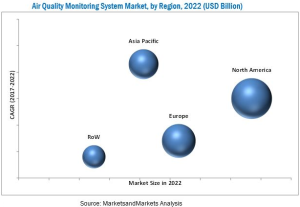The global air quality monitoring system market is expected to grow at a CAGR of 4.6% between 2017 and 2022. Factors such as supportive government regulations for effective air pollution monitoring and control, ongoing initiatives towards the development of environment-friendly industries, increasing public-private funding for effective air pollution monitoring, rising levels of air pollution, and increasing public awareness related to the environmental and healthcare implications of air pollution are driving the overall demand for air quality monitoring systems across key markets.
 Download the PDF Brochure@ http://bit.ly/2QFay79
Download the PDF Brochure@ http://bit.ly/2QFay79
Analysis of the market developments between 2015 and 2018 revealed that several growth strategies such as product launches, enhancements, strategic acquisitions, agreements, partnerships, collaborations, and expansions were adopted by the market players to strengthen their product portfolios and maintain a competitive position in the air quality monitoring systems market. Among these business strategies, product enhancements, agreements, and partnerships were the most widely adopted growth strategies by the players in the air quality monitoring systems market.
Thermo Fisher Scientific (US) held the leading position in the global air quality monitoring system market. The company possesses a robust AQM portfolio that includes products for ambient gas monitoring, emission monitoring, and particulate monitoring. The company has a strong geographic presence across North America, Europe, APAC, and Africa.
The company primarily focuses on new product launches and product enhancements as its key growth strategy to sustain its leadership position in the air quality monitoring system market. With regard to this strategy, the company has launched several AQM products in last three years, such as iQ Series gas analyzers (August 2017) Thermo Scientific 253 Plus 10kV Isotope Ratio Mass Spectrometer (in December 2015), and Thermo Scientific PDM3700 (in March 2015).
Siemens (Germany) held the second position in the air quality monitoring system market in 2016. The company has a strong AQM product portfolio, well-established distribution network, and wide geographic presence across the globe. The company mainly focuses on product launches and partnerships as its key growth strategy to strengthen its position in the global air quality monitoring system market. To increase its market visibility, the company launched the Siemens China Indoor Air-Quality Campaign in 2017 and also partnered with EuNetAir (European Network on New Sensing Technologies for Air Pollution Control and Environmental Sustainability) to provide industry views on the need for indoor AQM in the European region in 2016.
As of 2016, Thermo Fisher Scientific (US) held the leading position in the global air quality monitoring system market. The company possesses a robust AQM portfolio that includes products for ambient gas monitoring, emission monitoring, and particulate monitoring and has a strong geographic presence across North America, Europe, APAC, and Africa. The company primarily focuses on new product launches and product enhancements as its key growth strategy to sustain its leadership position in the air quality monitoring system market. Also, Teledyne Technologies, Inc. (US), Siemens Ltd. (Germany), Emerson Electric Co. (US), and General Electric (US) were few other key players operating in the market.
Read the Detailed Article@ https://www.marketsandmarkets.com/Market-Reports/air-quality-monitoring-equipment-market-183784537.html
Target Audience
- Manufacturers and distributors of AQM products
- AQM software developers
- Research laboratories and academic institutes
- Air pollution monitoring committees
- Pharmaceutical and biotechnology companies
- Government and non-government agencies
- National and regional air pollution control boards and organizations
- Petrochemical and biofuel product manufacturing companies
- Metals and mining companies
- Oil and gas production and distribution companies
- Gas operators, distributors, and regulators
- Power generation and power distribution units
- Municipalities and municipal corporations
- Sewage and wastewater treatment plants
- Food and beverages manufacturing companies
- Market research and consulting firms